Weak Fault Feature Extraction for Rolling Element Bearing Based on a Two-Stage Method
Abstract
Timely and effective feature extraction is the key for fault diagnosis of rolling element bearing (REB). However, fault feature extraction will become very difficult in the early weak fault stage of REB due to the interference of strong background noise. To solve the above difficulty, a two-stage feature extraction method for early weak fault of REB is proposed, which mainly combines feature mode decomposition (FMD) with a blind deconvolution (BD) method. Firstly, based on the impulsiveness and cyclostationary characteristics of the vibration signal of faulty REB, FMD is used to decompose the complex original vibration signal into several modes containing single component. Subsequently, the sparse index (SI) is calculated for each mode, and the mode containing sensitive fault feature is selected for further analysis. Subsequently, apply the deconvolution method on the selected mode for further enhancing the impulsive characteristic. At last, traditional envelope spectrum (ES) analysis is applied on the filtered signal, and satisfactory fault features are extracted. Effectiveness and advantages of the proposed method are verified through experimental and engineering signals of REBs.
1. Introduction
REBs are commonly utilized in various industrial applications, such as helicopters, high-speed trains, and wind turbines [1]. As the most commonly used component in rotating machinery, REB is also one of the most prone to failure components. Research on prognosis of REBs has becoming one hot area in recent decades. Effective fault feature extraction could provide powerful support for timely and correct fault diagnosis of REB. Significant progress has been made in the area of feature extraction based on vibration signal processing methods: from the initial FFT [2], ES analysis [3], wavelet transform (WT) [4], empirical mode decomposition (EMD) [5], variational mode decomposition (VMD) [6], spectral kurtosis (SK) [7] and its improved methods [8–11], minimum entropy deconvolution (MED) [12] and its improved methods [13–16], cyclostationarity theory with its related researches [17–19], to the later sparse decomposition [20–24] and denoising method based on deep learning [25–30]. However, the performance of some of the above methods is more or less insufficient when the characteristic signal of faulty REB is disturbed by strong background noise, especially in the early weak fault stage of REB, which will be verified in the comparison section.
It is well known that the vibration signal of faulty REB often presents periodic shock characteristics. ES analysis is a traditional and effective method for extracting the fault features of REB. However, it often fails to achieve satisfactory results by applying full-band ES on the original signal of faulty REB directly, and it is an important research direction to study how to select a frequency band containing a large number of shock components and then perform ES analysis on the selected frequency band, that is, the resonance demodulation technology (RDT). The above-mentioned SK analysis method is the milestone representative of RDT. Unfortunately, as proved by McDonald et al. [13], SK is sensitive to the instantaneous shock and could not reflect the continuous periodic shock characteristics of the vibration signal of faulty REB effectively, which often leads to misjudgment. Although the improved methods of SK have solved the above-mentioned shortcoming of SK to some extent, as stated in reference [31], the selected frequency band in the above improved methods of SK might not be the optimal frequency band due to the influence of strong background noise and the complexity of signal components. In addition, the periodic shock characteristic components might be divided into two adjacent frequency bands, resulting in the loss of useful information. Furthermore, the noise and interference components in the selected frequency band might also be enhanced by RDT, which further hinders its wonderful performance. BD is another effective method to enhance the impact characteristic signal of REB and eliminate the effect of signal acquisition path on signal attenuation, which filters the original signal by finding an optimal inverse finite impulse response (FIR) filter to eliminate noise and interference components. Selection of the optimal filter parameters is achieved by minimizing or maximizing a specific index of the filtered signal. The classical BD method, also well known as MED, maximizing the kurtosis of the filtered signal is used in fault diagnosis of rotating machinery successfully [12]. Aiming at the sensitivity of the kurtosis index to additional shock interference, the OMED [32] method is proposed, which solves the above shortcomings of MED to a certain extent. The shock index can describe the cyclic shock characteristics of the signal of faulty REB effectively and is used in the BD method [33]. Besides, kinds of BD methods based on other indicators have been proposed one after another and have been widely used in the fault diagnosis of REB [34–37]. The above BD methods do not consider the prior information of faulty REB into BD, and some BD researches try to apply prior information to BD, among which the fault characteristic frequency of faulty REB is the most commonly used prior information. Based on the prior fault characteristic frequency, a BD method based on maximum correlation kurtosis, namely, MCKD method, is proposed [13]. Subsequently, kinds of BD methods based on the prior information such as defined target vector [38] and cyclostationarity [39, 40] have been arising. Inspired by the above BD researches’ idea based on prior information, the fault characteristic period of faulty REB, this paper used a BD method based on an index describing the noise intensity of periodic cyclostationary signal. The used BD method not only could demodulate one or more resonance frequency bands excited by periodic shock components adaptively but also can eliminate the fault-irrelevant frequency components in the resonance frequency band effectively.
Due to the complexity and diversity of the original signal components of faulty REB, although the repetitive impacts could be enhanced by the used BD method, the intrinsic characteristic of the other components might also be enhanced simultaneously. Adaptive nonstationary signal processing methods such as WT, EMD, and VMD can decompose nonstationary vibration signals into a series of single-component signals and perform BD methods on the decomposed single-component signal that could solve the above problems to a certain extent. However, the selection of the WT base function has great chance on the decomposition result, and it is necessary to know the prior knowledge of the signal to be analyzed in advance to establish the optimal wavelet base in order to obtain satisfactory decomposition effect. EMD has the problem of modal aliasing. Although the subsequent improved methods of EMD [41–43] can overcome the mode aliasing problem effectively, they often have the disadvantage of large amount of calculation. VMD needs to determine the optimal mode decomposition order in advance, which is difficult to be achieved in most engineering applications. As a new no-stationary time-frequency method, FMD [44] takes the impulsiveness and periodicity of fault signal into consideration simultaneously and could remove the redundant and mixing modes adaptively in the decomposition process. So FMD is used in the paper as an alternative to the above traditional TF analysis methods and is used as preprocessing method for the used BD method.
- (1)
SI is used to reflect the amount of repetitive impacts buried in the vibration signal of faulty REB, which is much more reliable than the other index such as kurtosis and the other indexes
- (2)
The BD method not only could demodulate one or more resonance frequency bands excited by periodic shock components adaptively but also can eliminate the fault-irrelevant frequency components in the resonance frequency band effectively
- (3)
FMD is used as preprocessing method for the BD method, and the combined method has advantages over the other related methods
The remains of the paper are organized as follows: Section 2 is dedicated to the BD method. Flow chart of the proposed method and its details are given in Section 3. Section 4 and Section 5 are the experiment and engineering verifications, respectively. Comparison is carried out in Section 6, and conclusions are obtained in Section 7 at last.
2. The BD Method
The solution of the PNAR’s gradient could use the backward automatic differentiation algorithm [46].
The detailed calculation processes of the BD method are presented in Algorithm 1.
-
Algorithm 1: The detailed calculation processes of the BD method.
-
Input: The measured vibration signal s, the fault period T, noise ratio ρ, the iteration number N.
-
Initialize filter as f0 randomly.
-
Fort = 1, 2, ⋯, N, do
-
Calculate the filtered signal x: x = s∗ft−1.
-
Compute the PNAR of the filtered signal x.
-
Compute the gradients gt by backward automatic differentiation.
-
Determine the filter ft for the next iteration via Adam.
-
End
-
Output: The filtered signal x.
3. Flow Chart of the Proposed Method
Flow chart of the proposed method is given in Figure 1, and the details of each step are as follows.
Step 1. Collect the vibration signal of faulty REB and input it into the calculation model of FMD (details of FMD could be referred to reference ([34]).
Step 2. The SIs of each mode obtained by FMD in Step 1 are calculated.
Step 3. The mode obtained in Step 1 with the biggest value of SI is selected for further analysis due to reason that it contains the maximum amount of repetitive impact characteristic components.
Step 4. Calculate the fault period of the diagnosed faulty type, and input it with the selected mode into the BD calculation model simultaneously.
Step 5. Apply ES analysis on the output signal obtained in Step 4, and the satisfactory fault features are extracted.
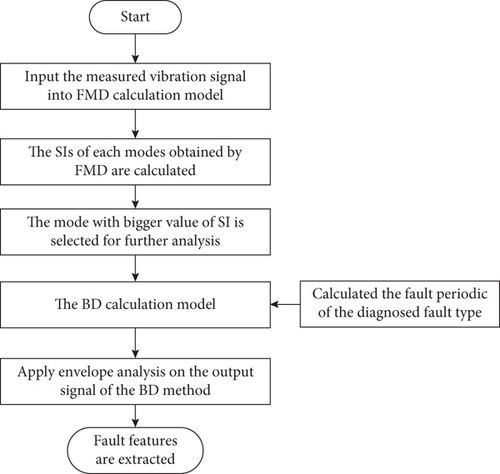
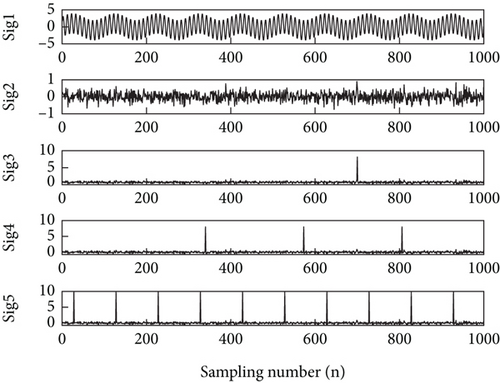
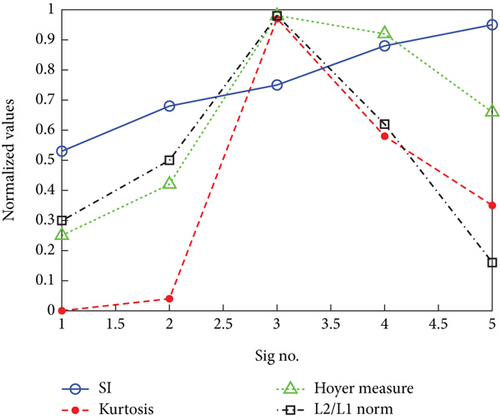
4. Experiment Verification
The conventional failure experiments of REB are often simulated by processing faults on the components (inner race, outer race, rolling element, or cage) of REB using EDM technology, and the fault features are often obvious, which could be extracted effectively by applying ES analysis on the original faulty signal directly, so the early weak fault of REB could not be simulated by conventional failure experiments. This experiment is more convincing to verify the effectiveness of the proposed method by using the data collected from the early failure stage of the REB accelerated fatigue life experiment. The actual picture of the test bench is shown in Figure 3(a). The so-called accelerated fatigue test is to apply additional load to the test REB to accelerate its fatigue damage rate without affecting the damage mechanism of the REB. Figure 3(b) shows the schematic diagram of the additional load loading on the experimental REB, and Figure 3(c) shows the schematic diagram of the sensor installation. The experimental data of one of the bearings is selected for analysis, and the parameters and the fault characteristic frequencies of the selected test rolling bearing are shown in Tables 1 and 2, respectively. In Table 2, fr is the rotating frequency of the rolling bearing, fc is the fault characteristic frequency of the rolling bearing cage, and fb, fi, and fo are the fault characteristic frequencies of rolling bearing’s rolling element, inner race, and outer race. One group of 20480 points is collected per minute with sampling rate 25.6 kHz. Finally, the selected REB is disassembled, and it is found that fault arises on the inner race of the selected REB. The kurtosis and amplitude indicators of the selected bearing’s vibration data throughout its life cycle are shown in Figures 4(a) and 4(b), respectively. It could be seen that the kurtosis and amplitude indexes of the REB’s life cycle data do not change abruptly before the 2297th minute, so the data collected at the 2297th minute can be regarded as the early weak stage of the selected REB, and its time-domain waveform is presented in Figure 4(c). Apply ES analysis on the original weak fault signal, and the corresponding result is given in Figure 4(d), based on which the distribution of spectral lines is disorganized, and the fault characteristic frequency of the selected bearing could not be extracted effectively.
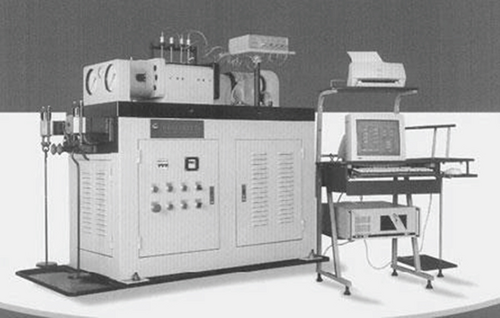
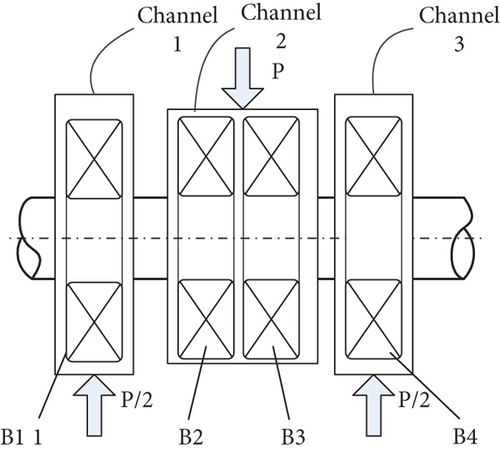

| Type | Ball number | Ball diameter (mm) | Pitch diameter (mm) | Contact angle | Motor speed (rpm) | Load (kN) |
|---|---|---|---|---|---|---|
| 6307 | 8 | 13.494 | 58.5 | 0 | 3000 | 12.744 |
| fr | fc | fb | fi | fo |
|---|---|---|---|---|
| 50 Hz | 19 Hz | 102 Hz | 246 Hz | 153 Hz |
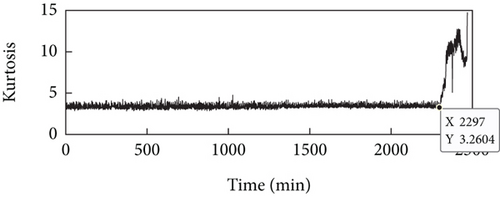
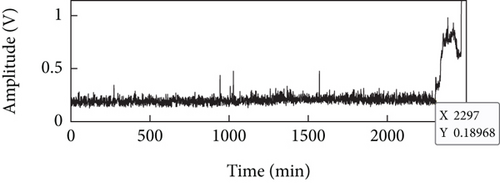
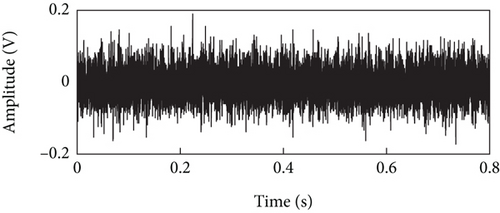
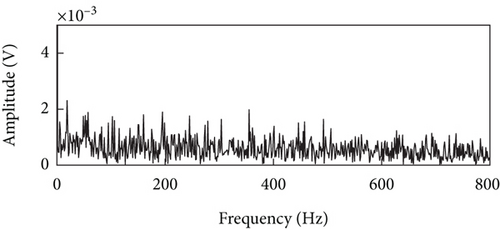
Figure 5 gives the filtered results by applying the BD method on the original signal as shown in Figure 4(c) directly. It could be observed that the impulse characteristics are enhanced evidently compared with the original signal. The modulation phenomenon could be observed based on FFT spectrum of the filtered signal, and the inner race fault characteristic frequency (245 Hz) could be extracted by the ES of the filtered signal. However, the harmonics of the inner race fault characteristic frequency could not be extracted.
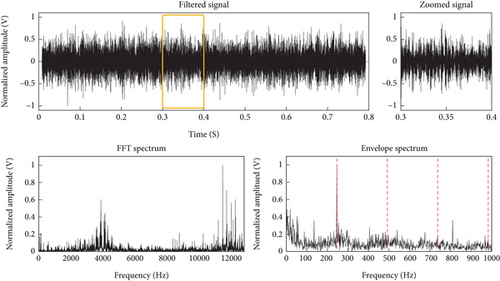
Apply the proposed method on the original experiment signal, and Figure 6(a) shows the main two decomposed modes (there are six modes obtained) by applying FMD on the original experiment signal. Then, the SI of the six modes is calculated, respectively, and the mode with bigger SI is selected for further BD analysis. The ESs of the two main obtained modes are shown in Figure 6(b), based on which the strong separation ability of FMD is further verified: The first mode mainly contains the rotating frequency components and its harmonics, and the second mode containing impulse characteristic components is still influenced by noise, because the inner race fault characteristic frequency could not be identified. Subsequently, the impulse characteristic of the second mode is enhanced by the BD method, and the results are presented in Figure 7 based on which the inner race fault characteristic frequency (245 Hz) with its harmonics of the selected REB is extracted successfully, and effectiveness of the proposed method is verified. Besides, whether compared with the original signal shown in Figure 4(c) or to the BD filtered signal shown in Figure 5, the impulse feature enhancement effect of the proposed method is the best.


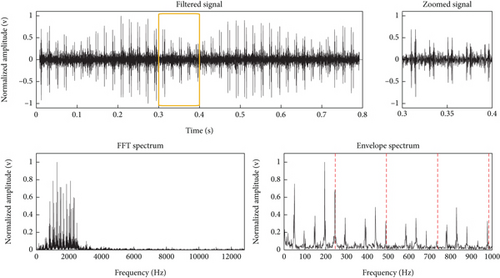
5. Engineering Verification
The engineering inspected object is the raw material grinding equipment of a cement plant. Schematic diagram of the unit structure is shown in Figure 8: The output speed of the driving motor is decelerated by the gearbox to drive the grinding equipment to work. In the daily maintenance of the equipment, it is found that the vibration value of the free end of the motor is too large, and the measured vibration value is shown in Table 3. The free end bearing of the motor is disassembled after shutting down the equipment, and it is found that failure arises on the inner race. The real picture of the inner race fault is shown in Figure 8(b). The equipment detection instrument is the equipment status detection and safety evaluation system produced by Zhengzhou Expert Technology Co., Ltd. The sensor model is EAJ03-100, and its sensitivity is 100 mv/g. The sampling frequency and sampling length are 3200 Hz and 8192 points, respectively. The type of the monitored bearing is NU244. According to the calculation formula of the fault characteristic frequency of rolling bearing components, the calculated fault characteristic fault frequencies of the monitored bearing are shown in Table 4.

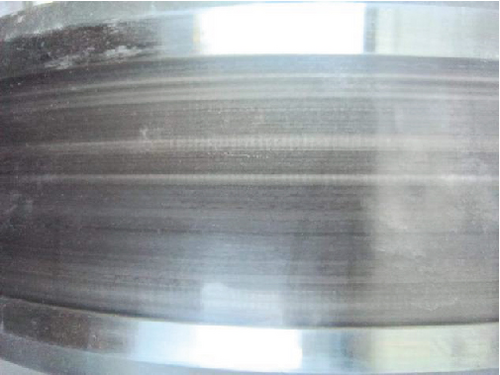
| Number | Measured point | Direction | Value (mm/s2) | Value (mm/s) |
|---|---|---|---|---|
| 1 | Free end of motor | Horizontal | 46.65 | 0.74 |
| 2 | Vertical | 26.51 | 0.56 |
| Type | Inner race (Hz) | Outer race (Hz) | Ball (Hz) | Cage (Hz) |
|---|---|---|---|---|
| NU244 | 126.12 | 98.00 | 90.50 | 5.16 |
Effectiveness of the proposed method is verified by the vibration data of the channel with larger amplitude in Table 1, that is, the channel in the horizontal direction. Time-domain waveform and full-band ES analysis results of the analyzed data are shown in Figures 9(a) and 9(b), respectively. In Figure 9(a), although the shock features can be observed, they are not obvious enough by calculating the interval between two shocks directly, that is, the failure period. In Figure 9(b), the frequency with the larger amplitude cannot correspond to the fault characteristic frequency shown in Table 2, which can easily lead to misdiagnosis or missed diagnosis. The signal shown in Figure 9(a) is decomposed by FMD firstly according to the proposed method. The number of FMD decomposition modes is set to 4, and the corresponding decomposition results are shown in Figure 10: Figure 10(a) is the obtained two main modes, and Figure 10(b) is their corresponding envelope spectrums. According to the spectral structure characteristics of Figure 10(b), FMD successfully decomposes the signal shown in Figure 9(a) into two main modes with relatively single components: The spectral line structure in the upper graph in Figure 10(b) is dominated by the rotating frequency and its harmonics, indicating that the components contained in the corresponding mode are mainly the components of motor rotating frequency signal; the fault characteristic frequency of inner race of the monitored bearing could be reflected clearly relatively in the lower graph of Figure 10(b), indicating that the corresponding mode mainly contains periodic impact characteristic components. Figures 10(c) and 10(d) are the frequency spectrum of the signals shown in Figure 10(a), which further verifies the better separation effect of the FMD method for the signal shown in Figure 9(a): The two modal signals are concentrated in the low frequency (rotation frequency and its harmonic frequency) and the high frequency part (the characteristic component of impact failure of rolling bearing). Besides, the SIs of the two modes are very different, and the second mode is bigger than the first mode, so the second mode is selected for further analysis. However, the motor rotating frequency and its harmonics still cause relatively strong interference on the inner race fault characteristic frequency in the lower graph of Figure 10(b). Besides, the harmonics of the inner race fault characteristic frequency are not extracted. Further fault information sensitive frequency band selection analysis is needed. Apply the BD method on the second mode as shown in Figure 10(a), and the corresponding results are given in Figure 11: Comparing the filtered signal with the original mode signal shown in Figure 10(a), the impulse characteristics of the former are not only enhanced effectively, but also, the modulation features are more obvious. Through statistical calculation, the former is 3.2 times that of the latter. Besides, it could be observed that not only the inner race fault characteristic frequency and its harmonics are extracted based on the frequency spectrum and envelope spectrum of the filtered signal but also the modulating frequency; that is, the rotating frequency is extracted when failure arises on the inner race of bearing. Effectiveness of the proposed method is further verified through the analysis results of this engineering signal.

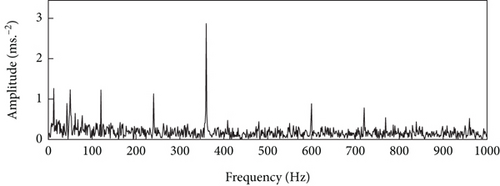
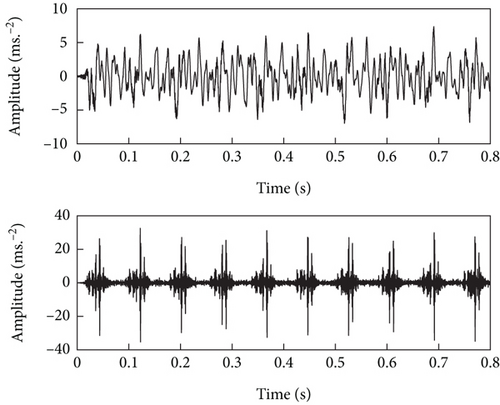
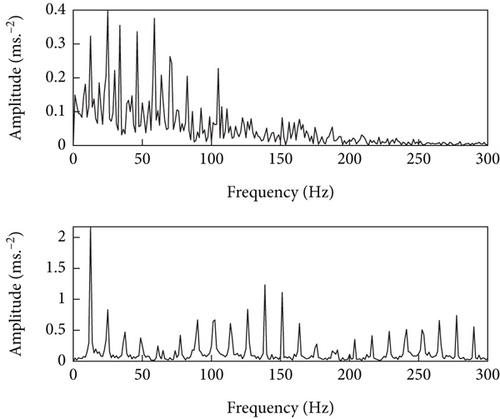
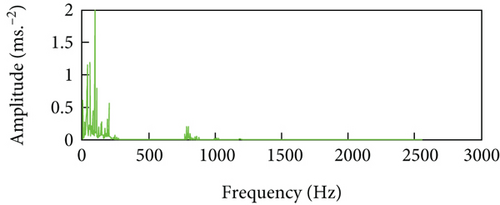
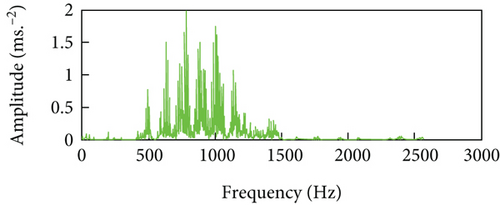
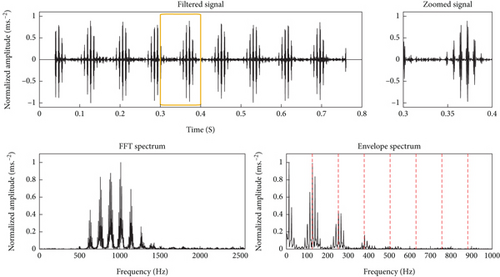
6. Comparison
In the section, two methods are used for comparison to verify the advantages of the proposed method. The first one is a new time-frequency decomposition method, and the second one is a new frequency band selection method based on cyclostationarity.
As a relative time-frequency analysis method, successive variational mode decomposition (SVMD) [48] is an improved method of VMD, which overcomes the defect of VMD needing determine the precise number of modes in advance. Besides, the modes containing single component could be extracted successively by SVMD without needing to know the number of modes. In the section, SVMD is used to compare first and to decompose the original experimental signal shown in Figure 4(c), and the obtained series of modes are presented in Figure 12(a). Then, the SIs of the obtained modes are calculated, and the mode as shown in Figure 12(b) owning the biggest SI is selected for ES analysis, and the last result is given in Figure 12(c). The inner race fault characteristic frequency could be extracted based on Figure 12(c). However, its harmonics are not extracted the same as the extracted result as shown in the last figure of Figure 7 by using the proposed method.

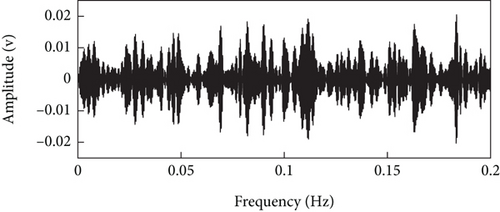
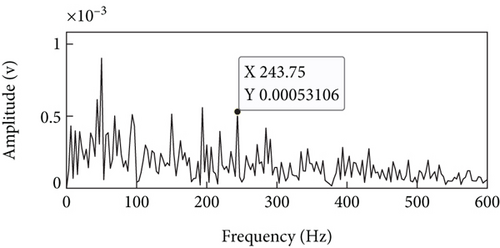
Cyclostationarity is another classical and effective method, and spectral correlation (SC) with its normalized version based on cyclostationarity, that is, SCoh [49], is the most effective second-order cyclostationary method for fault feature extraction of REB. Then, squared envelope spectrum (SES) or enhanced envelope spectrum (EES) for identifying the fault characteristic frequencies could be obtained by integrating SCoh over the whole spectral frequency band. But the defect of SES or EES is sensitive to noise. To address this issue, a feature-adaptive method called IES via Candidate Fault Frequency Optimization-gram (IESCFFOgram) [50] is proposed to determine the informative spectral frequency band from SCoh for bearing fault diagnosis, which is used as the second method for comparison. The last analysis results are given in Figure 13(d): Figure 13(a) is the spectral coherence of the signal shown in Figure 4(c), Figure 13(b) is the EES result based on Figure 13(a), and Figure 13(c) is the IESCFFOgram spectral result. Unfortunately, the inner race fault characteristic frequency is not extracted, and the main reason is due to the inference of strong background noise and the complex multicomponent of the original fault signal.
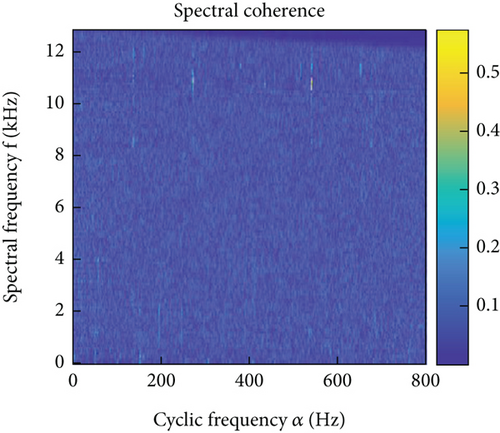
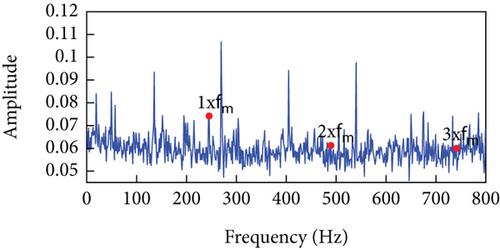
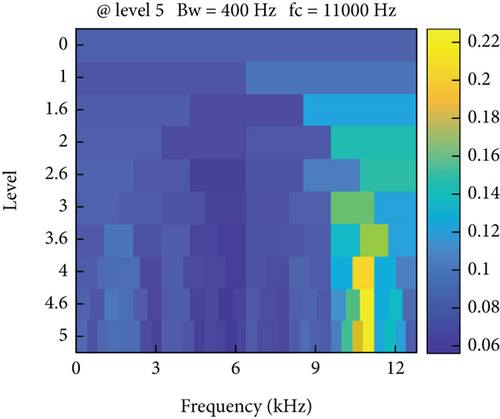
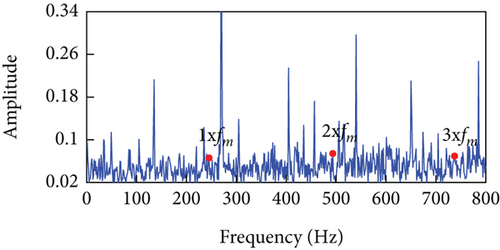
7. Conclusion
- (1)
SI could reflect the periodic impact signal much more effectively than the other related indexes through simulation verification
- (2)
FMD could separate the complex multicomponent signal into several modes containing relative single component through experiment and engineering verification, which could overcome the defects of traditional time-frequency analysis methods such as wavelet transform, EMD, and VMD
- (3)
The BD method could enhance the impact characteristics of REB’s vibration signal effectively through experiment and engineering verification
- (4)
The proposed combined method could extract the fault features of REB much more effective than the other methods through comparison
In addition, some parameters used in the used methods are obtained through experience and trials. So, research on adjusting the algorithm parameters will be carried out in the further work. Besides, the paper mainly solves the difficult problem of extraction of weak fault features of rolling element bearing under constant speed. In the future research, the order tracking analysis method being suitable for analyzing variable speed conditions will be combined with the proposed method to extend the research for fault diagnosis of rotating machinery working on variable speed condition and make the proposed method more universal in engineering application.
Conflicts of Interest
The authors declared no potential conflicts of interest with respect to the research, authorship, and/or publication of this article.
Acknowledgments
The research is supported by the National Key R&D Program of China (approved grant: 2020YFB2007200) and the Key Science and Technology Research Project of the Henan Province (approved grant: 232102221039).
Open Research
Data Availability
The data could be available on request.




